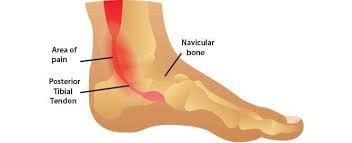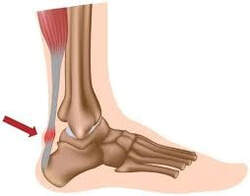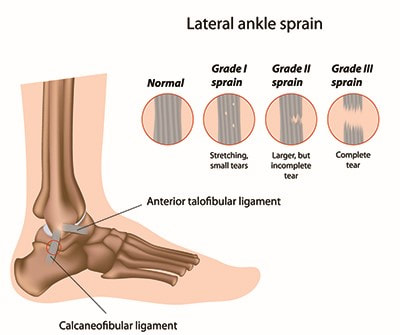|
A runner is as susceptible to ankle pain as any other lower limb injury. The repetitive demands of continual load acceptance during the running gait can create a high level of stress through this joint. The result ranges from an increasingly uncomfortable run to a complete inability to weight bear. Either scenario can be catastrophic to a carefully planned training programme or even the disruption to a regular health and wellbeing activity. The Ankle is made up of three bones, the Tibia and Fibular of the lower leg and the talus in the foot. These bones are held together by a series of ligaments most of which run along either side of the ankle joint. These ligaments offer stability to the ankle. There are also several tendons that cross the ankle attaching to muscles higher up the leg which create the movement of this joint. Each of these structures can become injured when running. The most common causes and types of injury are discussed in this article. Sprains What is it and what causes it? An ankle sprain is a generic term for an injured ligament in the ankle. However, there are numerous ligaments that can become injured in the ankle, all of which may be caused by a different movement. A sprain is caused when a joint is stretched passed its natural available range. Ligaments are bands of connective tissue creating an attachment between bones, forming a joint. When the joint is over-stretched a ligament becomes stressed to the point it can tear. The most common sprain is a lateral ankle sprain. It is often termed a ‘rolled ankle’ this affects the ligaments on the outside of the ankle. It is also possible to sprain the ligaments that support the inside (medial aspect) of the ankle too. Site of pain is usually a good indicator of which ligaments you have injured. The least common of ankle sprains is a high ankle sprain (Syndesmotic injury), this effects the connective tissue between the two lower leg bones (Tibia and Fibula) and commonly causes pain just above the front of the ankle joint as supposed to the outside of the joint as with a common lateral ankle sprain. Just like Muscle strains, ligament sprains can be classified in the three categories, grade I, II or III. Runners may suffer an ankle sprain of any type by landing awkwardly into a stride, slipping off a curb, falling in a pothole, or tripping on uneven ground during a trail run. Symptoms
How to prevent it?
Stress fractures What is it and what causes it? Stress fractures are common in runners and have been widely discussed in the guide to running injury series. The repetitive high impact forces created during the running gait cycle are absorbed by many bones in the lower limb. Over time these repetitive forces result in microscopic trauma to the bones. Through inappropriate training programmes, this microscopic trauma does not have chance to remodel and can progress to create fine cracks (stress fractures). Most common stress fractures in the lower limb are found in the foot or shin. However, the Talus and Navicular bone are not immune to these stresses. They are located within the foot just below the ankle joint. Stress fractures will present with pain on weightbearing. This is worse on impact and settles at rest. It is often a localised sharp pain pinpointed to the site of the fracture. In the case of the talus and Navicular this may be in the front of the ankle or deep within the ankle joint. How to treat it?
How to prevent it?
Avulsion fractures What is it and what causes it? An avulsion fracture is when the forces stressed on a ligament or tendon are such that they create too much strain on the attachment causing a small piece of the bone to be pulled away with the ligament or tendon. The mechanism of these injuries is largely the same as a sprain and often presents in a similar way. Generally this is diagnosed by X-ray or CT scans. How is it treated?
Tendinopathy A tendinopathy is the degeneration of a tendon. Tendons attach a muscle to the bone. A tendinopathy occurs when a tendon is overused and subjected to adverse stresses. The subsequent degeneration is displayed as thickening, splitting or even tearing of the tendon. The repetitive nature of running and the high impact on the foot and ankle mean the numerous tendons around the ankle are vulnerable to tendinopathies if not managed sufficiently. Common sites affected are:
Symptoms associated with all these tendinopathies would be pain, swelling, weakness and even possible balance disturbances at the site of the respective tendon. As with all tendon injuries the pain tends to be prominent at the start of activities settling as the activity progresses. It may completely disappear at rest. Tendinopathies rarely get better without intervention and should not be ignored.  Tibialis posterior tendinopathy  Peroneal tendinopathy  Achilles Tendinopathy How to treat it?
0 Comments
Your comment will be posted after it is approved.
Leave a Reply. |
Taylormade
|
PERFORMANCE AND REHABILITATION CLINIC
Injury Management and Conditioning Specialist
Taylormade Rehab, 1 Belle Vue, Fenny Bridges, Honiton, Devon EX14 3BJ | 07800 824557 | 07855 386634
© 2019 Taylormade | Performance & Rehabilitation Clinic. Injury Management & Conditioning Specialists | Website design by brightblueC
© 2019 Taylormade | Performance & Rehabilitation Clinic. Injury Management & Conditioning Specialists | Website design by brightblueC






 RSS Feed
RSS Feed
